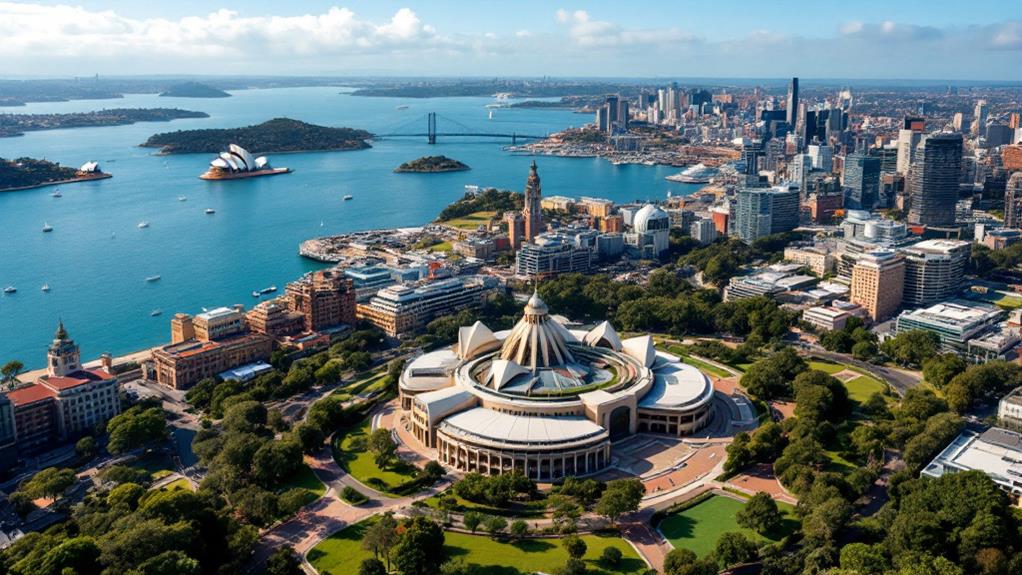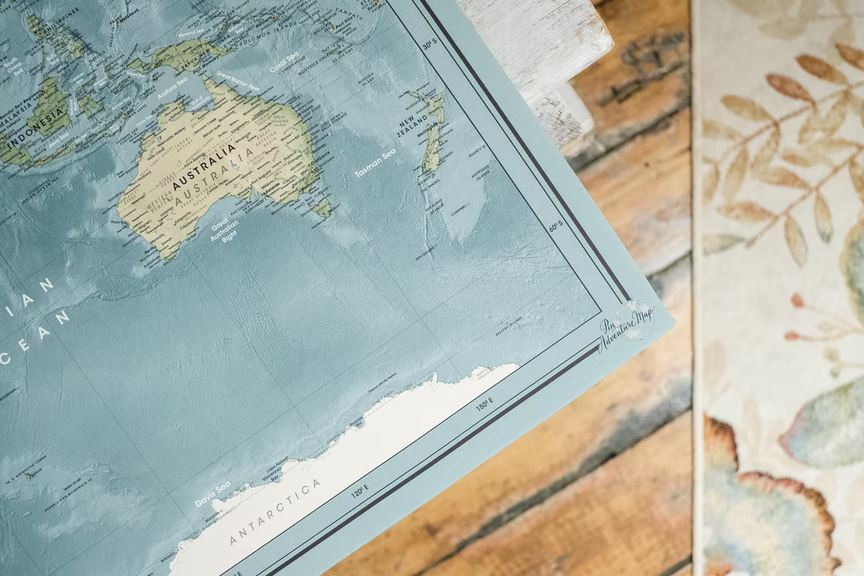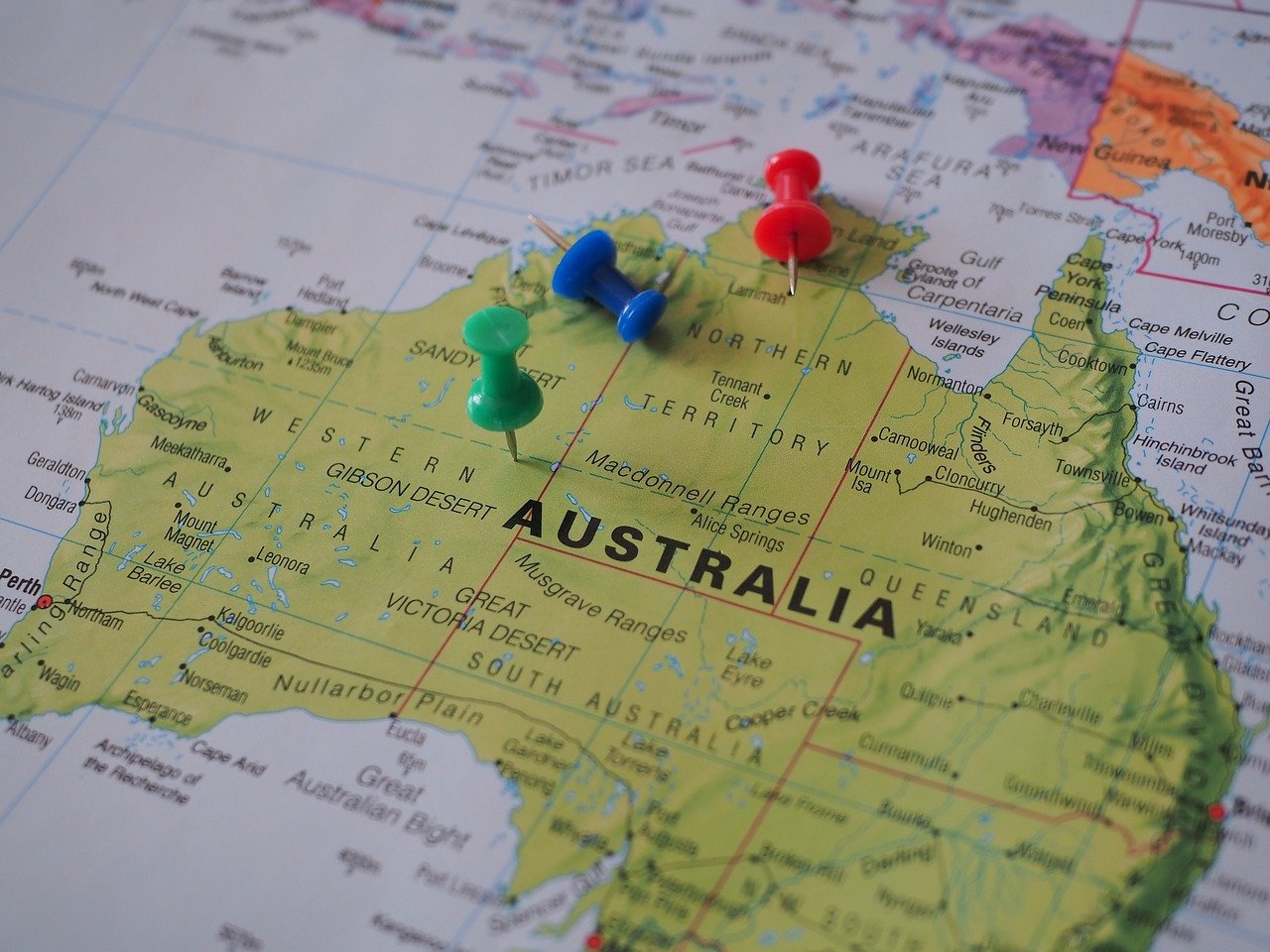What Is the Largest Urban Area in Australia? A Look at Population Centers
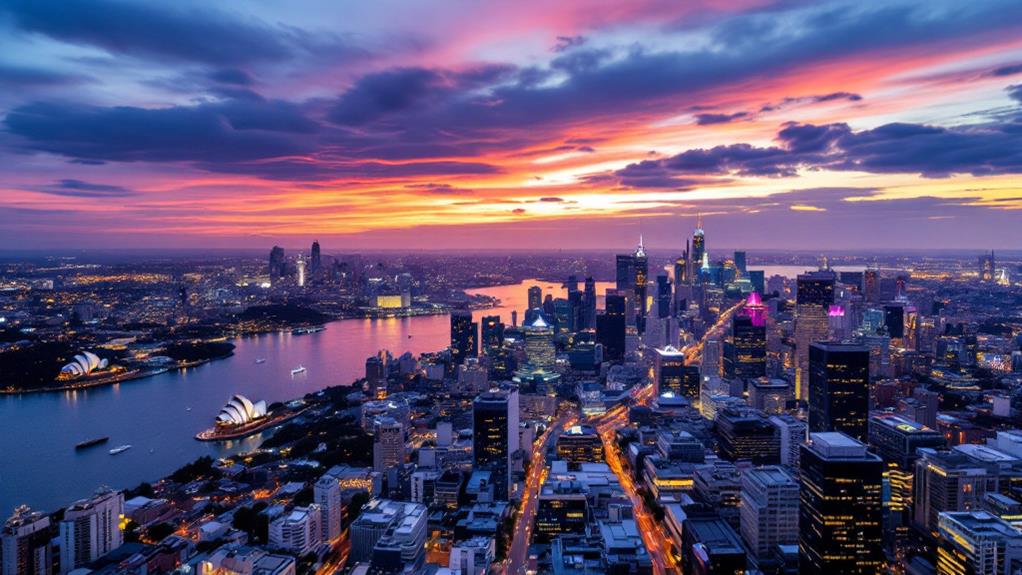
You're exploring Australia's largest urban area, Sydney, home to around 5.45 million people as of 2023. It serves as an economic and cultural hub, boasting iconic landmarks like the Sydney Opera House and Harbour Bridge. Melbourne, closely following with a population of 5.21 million, is rapidly growing, mainly due to interstate and overseas migration. Brisbane and Perth are also significant, each contributing to Australia's economy with their unique industries and lifestyles. If you're curious about how these cities shape Australia's future and urban trends, there's a lot more to uncover about the country's dynamic population centers.
Overview of Major Cities
When investigating Australia's major cities, you'll find that each offers its own unique blend of culture, economy, and lifestyle. Sydney stands as the largest urban area in the country, with a lively population of approximately 5.45 million. It's a colorful hub where economic prowess and cultural diversity intersect, offering a dynamic environment that's hard to match. As you move to Melbourne, you'll encounter the second largest city, home to about 5.21 million people. Known for its thriving arts scene and diverse economy, Melbourne captivates with its creative spirit and cultural offerings.
Heading north, Brisbane welcomes you with its warm climate and outdoor lifestyle. As the capital of Queensland, it houses around 2.71 million residents and is cherished for its laid-back yet energetic atmosphere. On the west coast, Perth emerges with a population of approximately 2.31 million. It thrives on its rich natural resources, offering a unique blend of urban and natural beauty. Finally, Adelaide, with its population of about 1.45 million, is renowned for its festivals and wine regions. These Australian cities each contribute their own flavor to the nation's rich tapestry, making them intriguing destinations to investigate.
Sydney's Population Dominance
Sydney's population dominance in Australia isn't just a statistical fact; it's a demonstration of its role as a lively economic and cultural powerhouse. As the largest urban area in the nation, Sydney boasts a population of approximately 5.450 million as of 2023. This impressive figure highlights the city's status as a crucial economic hub, drawing individuals from across the globe to its busy streets and colorful neighborhoods.
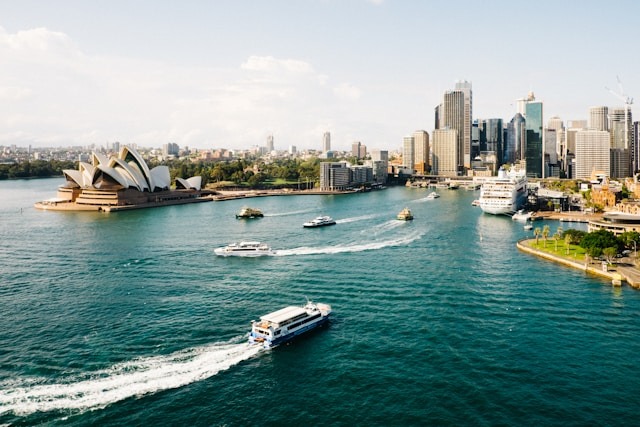
In the last decade, Greater Sydney has experienced significant growth of 24.11% from 2011 to 2022, underscoring its appeal and energy. Attractions like the iconic Sydney Opera House and Harbour Bridge aren't just tourist magnets; they symbolize the city's rich cultural dynamics. These landmarks, coupled with the diverse suburbs and neighborhoods, create a tapestry of cultures that contribute to Sydney's uniqueness and allure.
Looking ahead, Sydney's projected growth is remarkable, with an anticipated increase of 1.2 million residents by 2041. This growth further solidifies its position as Australia's leading urban area and reflects the city's ongoing evolution as a dynamic center of innovation and opportunity. Sydney's blend of economic vigor and cultural richness guarantees its continued prominence and appeal.
Melbourne's Rapid Growth
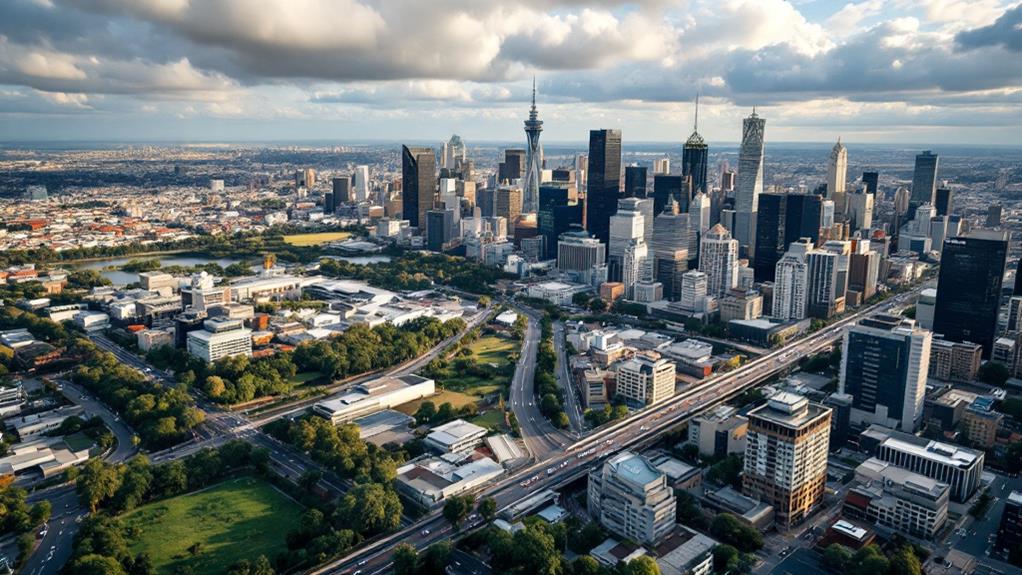
Momentum has been steadily building in Melbourne, propelling it to reclaim its status as Australia's largest city in 2022, surpassing Sydney by around 37,000 residents. You might wonder what's behind this impressive population growth. Melbourne's allure stems from several factors, including a lively arts scene that attracts both locals and newcomers. The city's cultural richness makes it an appealing destination for those seeking dynamic city life.
One significant driver of this growth is interstate migration. People from other parts of Australia are drawn to Melbourne's varied economy, which supports multiple industries, providing ample job opportunities. Furthermore, overseas migration plays a vital role. Many international residents choose Melbourne as their new home, contributing to its expanding population.
From 2011 to 2023, Melbourne's population surged by approximately 24%, growing from about 4.169 million to over 5.207 million residents. As a major urban center, it continues to thrive and attract more residents. By 2030, projections suggest Melbourne's population will surpass 6 million, further solidifying its status as a lively metropolis. For anyone considering a move, Melbourne offers an energetic lifestyle and endless opportunities in the heart of Australia's largest city.
Brisbane's Expanding Influence
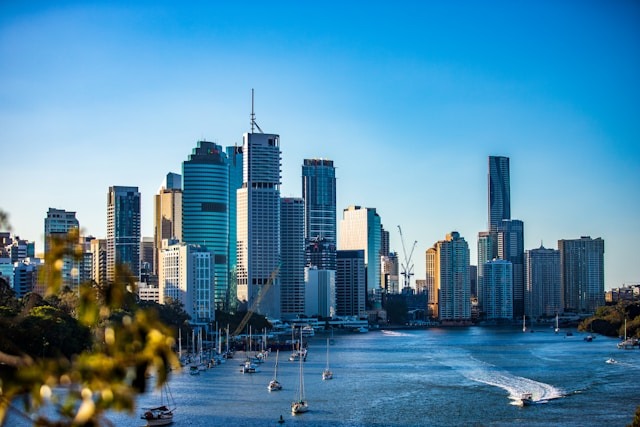
Brisbane, Australia's third-largest city, is rapidly gaining influence with a thriving population of around 2.7 million. You're witnessing an incredible growth rate of 26.06% from 2011 to 2022, making it a dynamic hub in Queensland. As a major economic center, Brisbane thrives on tourism, resources, and mining sectors, which play an essential role in enhancing Queensland's economy. Its subtropical climate and lively outdoor lifestyle, complete with parks and riverfronts, make it an attractive destination for both residents and tourists alike.
This lively city isn't just stopping there. The Greater Brisbane area is set for continued growth, driven by interstate migration and its appealing living conditions. You're likely to see more people choosing Brisbane as their home, thanks to its favorable climate and economic prospects. With this influx, infrastructure is a top priority. The city's investing in improved public transport and urban planning initiatives to guarantee it can handle the expanding population and seize new economic opportunities.
Brisbane's strategic focus on infrastructure and urban planning guarantees it remains a competitive and influential urban area. As the city continues to grow, it stands as a reflection of dynamic urban development and lively economic life in Queensland.
Perth's Economic Contributions
While Brisbane's growth captures attention on the east coast, Perth's economic contributions on the west coast are likewise important. With a population of approximately 2.3 million, Perth stands as a major economic hub in Western Australia. Its position is bolstered by the region's rich natural resources, particularly in mining and energy, which drive considerable employment opportunities. These industries not only contribute greatly to the state's GDP but also position Perth as an essential economic center in Australia.
Beyond resources, Perth's economic diversity spans finance, technology, and tourism. This diversification strengthens its economic resilience and appeal. Infrastructure investments have further improved Perth's status, attracting local and international businesses. These developments foster economic growth by enhancing connectivity and operational efficiency, making Perth an attractive destination for enterprises seeking new opportunities.
Additionally, Perth's strategic location as a gateway to Asia opens up vast trade and investment opportunities. This positioning facilitates economic contributions not just locally but nationally. The city's ability to connect with Asian markets underscores its role in bolstering Australia's trade relationships and economic landscape. As you consider Perth, recognize its crucial role in shaping Western Australia's economic future.
Adelaide's Cultural Significance
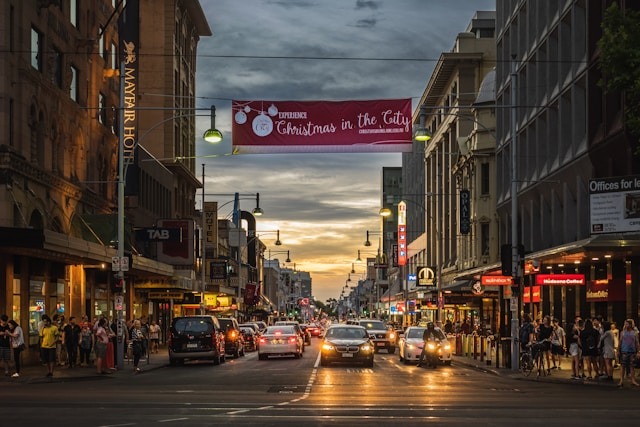
How does Adelaide stand out in Australia's cultural landscape? You'll find that it's the "City of Churches" not just by name, but by its rich tapestry of lively festivals and events. The Adelaide Festival of Arts and the Adelaide Fringe are two of the most prominent, drawing visitors globally and showcasing the city's thriving arts scene.
Adelaide's food and wine culture is another jewel in its crown. Located near the Barossa Valley and McLaren Vale, the city offers an incredible array of local wines and culinary delights that greatly benefit its economy. Regardless of whether you're a foodie or a wine enthusiast, Adelaide's gastronomic experiences are bound to impress.
Cultural institutions like the Art Gallery of South Australia and the South Australian Museum play crucial roles in preserving and presenting the city's artistic and historical heritage. They offer a rich collection of both local and international art and artifacts, making them must-visit spots for culture lovers.
With a population of approximately 1.4 million, Adelaide is Australia's fifth largest city. Its diverse community contributes to a lively social fabric, enriching the cultural significance of this dynamic urban hub.
Urban Development Trends
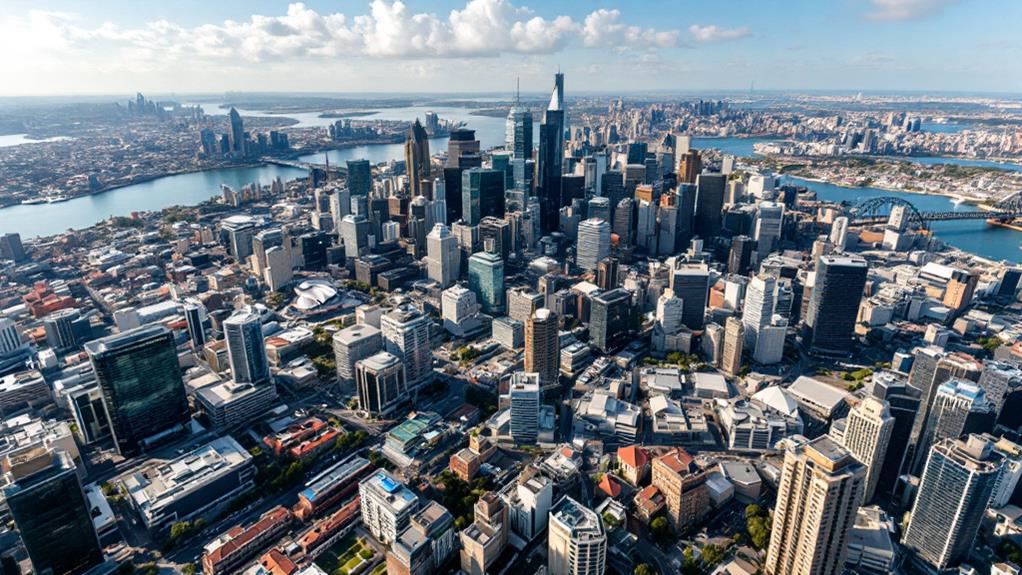
When you look at the urban development trends in Australia, you'll notice a dynamic shift in population growth across its major cities. Greater Sydney, as the largest urban area, boasts a substantial population of 5,450,496 as of 2023, highlighting a remarkable growth rate of 24.11% from 2011 to 2022. This makes New South Wales a significant urban area in the South, continually attracting people due to its economic and cultural dynamism.
Greater Melbourne follows closely, with a population of 5,207,145, and has experienced an impressive growth rate of 24.89% during the same period, underscoring its role as a key player in the urban landscape. Meanwhile, Greater Brisbane's growth rate of 26.06% signifies its rising prominence, becoming an attractive destination for new residents.
Emerging urban areas like Airlie Beach–Cannonvale and Byron Bay are also capturing attention. They've shown growth rates of 43.17% and 19.66%, respectively, reflecting shifting demographic trends and the appeal of regional locations. According to the Australian Bureau of Statistics, these trends illustrate a broader shift in where Australians choose to live, balancing between significant urban areas and the allure of emerging regions.
Economic Impact of Largest Cities
Australia's largest cities propel the nation's economy through diverse and powerful industries. In Sydney, the largest urban area, you'll find the country's financial heartbeat. Housing the Australian Stock Exchange, Sydney stands as a formidable economic center, driving growth and innovation. Melbourne's dynamic urban area complements Sydney by offering a diverse economy. Its key sectors, like finance, manufacturing, and technology, make it essential to Australia's economic success.
Brisbane, with its population of approximately 2.7 million, plays an essential role in Queensland's economy. It's not just the sunny weather that's appealing; Brisbane thrives on tourism and resource industries, reinforcing its status as an economic center. Moving west, Perth's economy is shaped by its abundant natural resources. The mining and energy sectors dominate here, making Perth a significant contributor to Australia's economic landscape.
Transportation Infrastructure
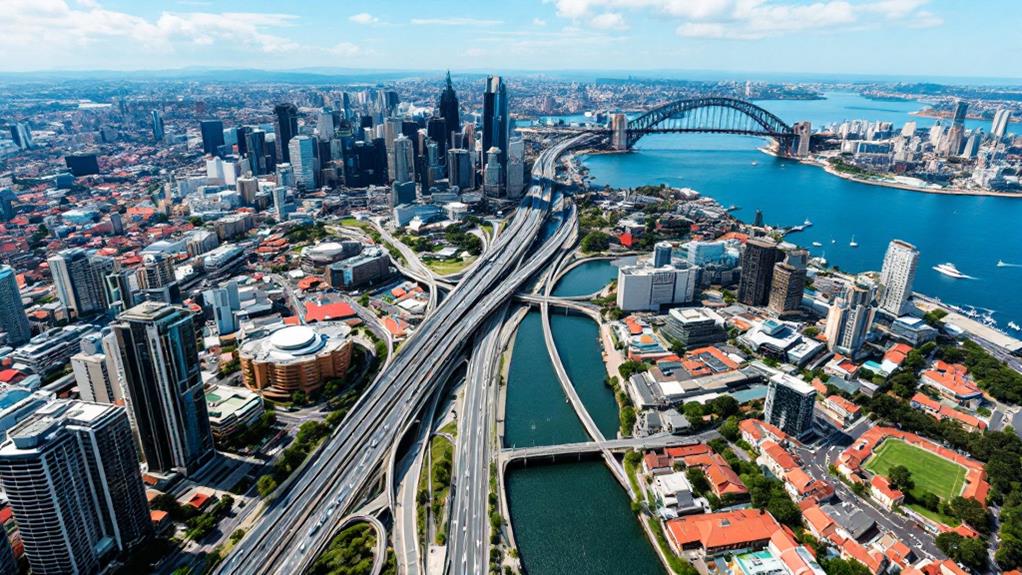
Transportation infrastructure in Australia's largest urban areas is crucial for their economic well-being and residents' quality of life. As a commuter, you'll find Sydney's extensive public transport network impressive, facilitating over 200 million passenger trips annually. With trains, buses, and ferries, Sydney offers a robust network that guarantees accessibility and efficiency in its metropolitan area.
In Melbourne, you can experience one of the world's largest tram networks, spanning over 250 kilometers. This vast network serves the metropolitan area, making it a convenient and sustainable public transport option for daily commuters. Melbourne's commitment to public transport infrastructure reflects its focus on improving urban mobility.
Brisbane stands out with a transportation system that emphasizes sustainability. Integrated bus, train, and ferry services cater to over 150 million passengers each year, supporting a greener future for the metropolitan area. Perth also prioritizes sustainability, with a transport system that includes trains, buses, and an expanding cycling network, aiming to reduce congestion and promote public transit use.
Adelaide's extensive bus and tram system enhances accessibility within the city, featuring over 80 bus routes and a tram line connecting the city center to the beach, improving the commuter experience in this dynamic metropolitan area.
Future Population Projections
As urban areas continue to rely on robust transportation networks, the anticipated population growth in Australia demands forward-thinking infrastructure strategies. By 2066, Australia's population could soar between 37.4 to 49.2 million, possibly exceeding 50 million by 2101. In this scenario, the urban landscape will transform notably, with cities like Melbourne, Sydney, and Brisbane centered on this growth trajectory.
Melbourne is on track to surpass Sydney as the largest city by 2030, thanks to its rapid growth trends. This shift underscores the need for Melbourne to invest heavily in infrastructure to support its expanding population base. You can expect a focus on housing, transportation, and public services to meet the demands of this burgeoning urban center.
Sydney, remaining a major urban hub, anticipates a population increase of 1.2 million by 2041. Effective infrastructure planning will be vital to maintain its status as a lively, livable city. Meanwhile, Brisbane is also experiencing considerable growth, driven by interstate migration and a favorable climate. As these cities evolve, strategic infrastructure investments are imperative to accommodate the swelling population and facilitate sustainable urban development across Australia's leading cities.

